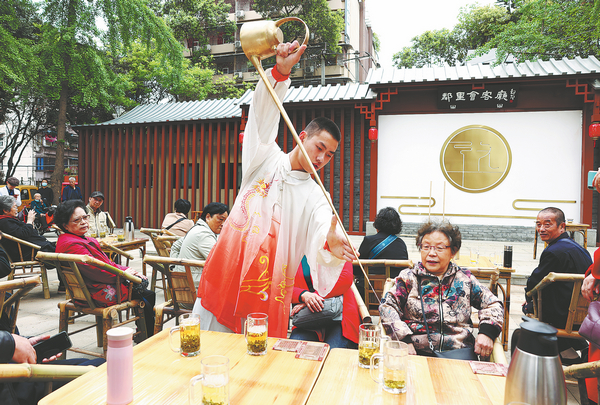Brewing up a sense of intimate community

Foreign visitors sip their favorite tea at a teahouse located near the Wuhou Shrine in Chengdu.
Teahouses can be found all over China, but those in Sichuan are quite different as they reflect the inherent leisureliness of local residents — and nowhere is that more evident than in the provincial capital of Chengdu.
Found everywhere from bustling markets to old streets, narrow alleys, parks, gardens and universities, Chengdu's teahouses come in all shapes and sizes — and on sunny days are invariably packed with patrons relaxing on bamboo benches or armchairs as they sip their favorite hot beverage. Traditional teahouses in Chengdu usually serve drinks in a covered bowl from a three-piece set that also includes a lid and saucer.
"The three-piece set of covered-bowl tea utensils should be of the best quality," said famous Ba-Shu culture scholar Yuan Tingdong. "The tea saucer supports the bowl, providing stability and convenience when picking up or putting down the bowl, preventing the tea from flowing onto the table or spilling on one's clothes. The tea bowl has a moderate capacity, larger on the top and smaller on the bottom, facilitating the rolling of leaves during brewing. The lid is not tightly sealed, which allows for heat preservation, dust prevention and ventilation, and it can also be used to stir the tea and block floating leaves when drinking."
Observing the service practiced in Chengdu teahouses is like watching an acrobatics performance. A staff member skillfully carries a tray of bowls to the table, and with one swift motion slides one in front of each customer. Then, with one hand grasping a long-necked copper pot, the server flips the lid with the other hand and pours a stream of steaming liquid into the bowl before quickly replacing the lid. It's all done with astonishing speed and graceful rhythm — with no mess!

Guests watch an acrobatic tea-pouring performance at a Chengdu teahouse.
For Chengdu locals, teahouses are more than just places to sip. Inside they can find people chatting, playing cards, discussing business, telling stories, shining shoes or selling melon seeds and tofu puddings. The diversity of activities often leaves visitors astounded.
In his book Ba-Shu Cultural Chronicle, Yuan writes: "Tea culture is a very important and distinctive part of Ba-Shu folk culture. The teahouse is a small Chengdu, and Chengdu is a big teahouse. Half of the city's residents are tea drinkers." The author also opines that teahouses are places for rest, socializing, entertainment, and the source of some people's livelihood. Patrons can make friends, conduct business, hear news, seek employment and mediate disputes.
For anyone wanting to experience the authentic teahouse culture of Chengdu, a visit to the century-old Heming Teahouse located in People's Park in the city center is highly recommended. People's Park once had six teahouses, but while some have moved or been rebuilt, Heming Teahouse, where scholars used to gather, retains its original form and is well maintained, preserving the original atmosphere of old Chengdu.
There is another century-old gem called Guanyinge Teahouse in Pengzhen town of Chengdu's Shuangliu district, with its old-style traditional Sichuan tile roof, walls and uneven muddy floors. The sunshine beats down on the cement stove and old aluminum kettle, and the worn tables and chairs add to the deep sense of history. Seemingly frozen in time, Guanyinge Teahouse is a popular stop for photography enthusiasts.
